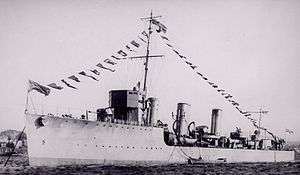HMS Ready (1916)
 Sister ship HMS Patriot | |
| History | |
|---|---|
| Name: | Ready |
| Builder: | Thornycroft, Woolston, Southampton |
| Yard number: | 828 |
| Laid down: | 2 September 1915 |
| Launched: | 26 August 1916 |
| Commissioned: | 31 October 1916 |
| Decommissioned: | 13 July 1926 |
| Fate: | Broken up at Garston, Liverpool |
| General characteristics | |
| Class and type: | Thornycroft M-class destroyer |
| Displacement: | 1,033 long tons (1,050 t) standard 1,208 long tons (1,227 t) full |
| Length: | 274 ft (83.5 m) |
| Beam: | 27 ft 6 in (8.4 m) |
| Draught: | 10 ft (3.0 m) |
| Propulsion: |
|
| Speed: | 35 kn (40 mph; 65 km/h) |
| Range: | 3,450 nmi (6,390 km) at 20 kn (37 km/h) |
| Complement: | 82 |
| Armament: |
|
HMS Ready was a destroyer of the M class which served with the Royal Navy. Launched by Thornycroft on 14 October 1916 as the first of six similar ships, the destroyer served as part of the Grand Fleet during World War I. Ready served in an escort role in the Grand Fleet until it was disbanded at the end of the War and was sold to be scrapped on 13 July 1926.
Design
Ready was one of two M-class destroyers ordered by the British Admiralty from John I. Thornycroft & Company in May 1915 as part of the Fifth War Construction Programme. Ready and Rapid differed from the Admiralty design in having more powerful engines, which gave them a higher potential speed.[1]
The destroyer was 274 feet (84 m) long overall and 265 feet (81 m) long between perpendiculars, with a beam of 27 feet 6 inches (8.38 m) and a draught of 10 feet (3.0 m).[2] Displacement was 1,033 long tons (1,050 t) normal and 1,208 long tons (1,227 t) full load.[3] Three Yarrow boilers fed steam to two sets of Brown-Curtis steam turbines rated at 27,500 shp (20,500 kW) and driving two shafts, giving a design speed of 35 knots (65 km/h; 40 mph), although the ship reached 34.36 knots (63.63 km/h; 39.54 mph) during trials.[2] Three funnels were fitted, the centre one being wider than the others, a feature shared with other destroyers designed by Thornycroft.[3] 275 long tons (279 t) of oil were carried, giving a design range of 1,620 nautical miles (3,000 km; 1,860 mi) at 20 knots (37 km/h; 23 mph).[4]
Armament consisted of three QF 4in Mk IV guns on the ship's centreline, with one on the forecastle, one aft and one between the second and third funnels.[2] Four 21 in (533 mm) torpedoes were carried in two twin rotating mounts.[5] By 1920, the ship was equipped with a single 2-pounder (40 mm) pom-pom anti-aircraft gun.[6] Fire control included a single Dumaresq and a Vickers range clock.[7] The vessel had a complement of 82 officers and men. [2]
Service
Ready was laid down on 2 September 1915 and launched on 26 August 1916.[8] On commissioning in October 1916, the ship joined the Grand Fleet, initially joining the Fifteenth Destroyer Flotilla.[9] The vessel was credited with bounty for the German auxiliary cruiser Konprinz Willhelm on 2 November 1917 along with Parker, Rigorous, Rocket, Rob Roy, Sharpshooter and Trenchant.[10]
Ready continued to serve with the Fifteenth Destroyer Flotilla until the end of the war.[11] When the Grand Fleet was disbanded, Ready was allocated to the defence flotilla at HMNB Portsmouth.[12] The destroyer was sold to King for breaking up at Garston, Liverpool on 13 July 1926.[8]
Pennant numbers
| Pennant Number | Date |
|---|---|
| G71 | September 1915[13] |
| G87 | January 1917[13] |
| G84 | January 1918[13] |
References
Citations
- ↑ Friedman 2009, p. 308.
- 1 2 3 4 Parkes & Prendegast 1919, p. 110.
- 1 2 Gardiner & Gray 1985, p. 79.
- ↑ March 1966, p. 143.
- ↑ Gardiner & Gray 1985, p. 80.
- ↑ March 1966, p. 146.
- ↑ "Fire Control in H.M. Ships". The Technical History and Index: Alteration in Armaments of H.M. Ships during the War. 3 (23): 31. 1919.
- 1 2 Colledge & Warlow 2006, p. 333.
- 1 2 3 Dittmar & Colledge 1972, p. 68.
Bibliography
- Colledge, J. J.; Warlow, Ben (2006). Ships of the Royal Navy: A Complete Record of All Fighting Ships of the Royal Navy From the 15th Century to the Present. London: Chatham. ISBN 1-93514-907-5.
- "Supplement to the Monthly Naval List Showing Organisation of the Fleet, Flag Officers' Commands, &c.: Destroyer Flotillas of the Grand Fleet". The Navy List. November 1916. Retrieved 3 October 2018.
- "Destroyer Flotillas of the Grand Fleet". The Navy List. December 1916. Retrieved 3 October 2018.
- "Destroyer Flotillas of the Grand Fleet". The Navy List. October 1918. Retrieved 3 October 2018.
- Dittmar, F.J.; Colledge, J.J. (1972). British Warships 1914–1919. Shepperton: Ian Allen. ISBN 0-7110-0380-7.
- Friedman, Norman (2009). British Destroyers: From Earliest Days to the First World War. Barnsley: Seaforth Publishing. ISBN 978-1-84832-049-9.
- Gardiner, Robert; Gray, Randal, eds. (1985). Conway's All the World's Fighting Ships 1906–1921. London: Conway Maritime Press. ISBN 0-85177-245-5.
- "List of Prize and Salvage Awards". The Navy List. October 1920. Retrieved 3 October 2018.
- "Local Defence and Training Establishments, Patrol Flotillas, Etc". The Navy List: 704. January 1921. Retrieved 3 October 2018.
- March, Edgar J. (1966). British Destroyers: A History of Development 1892–1953. London: Seeley Service & Co. ISBN 1-84832-049-3.
- Parkes, Oscar; Prendegast, Maurice (1919). Jane’s Fighting Ships. London: Sampson Low, Marston & Co. Ltd.